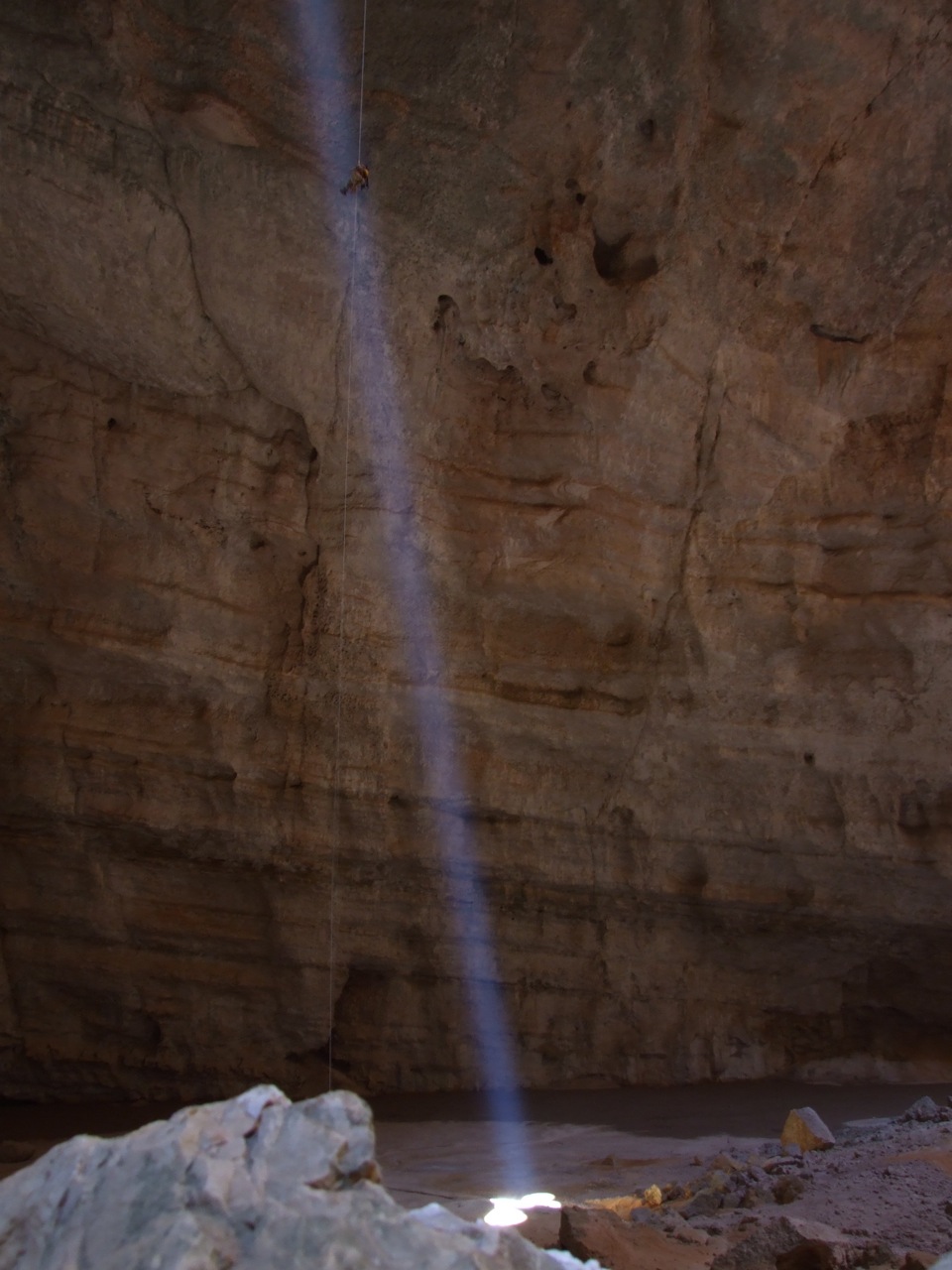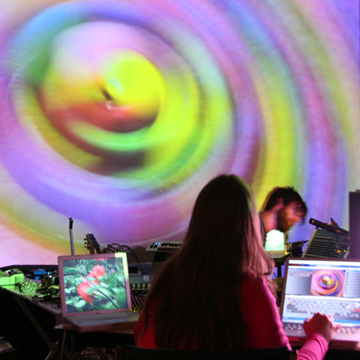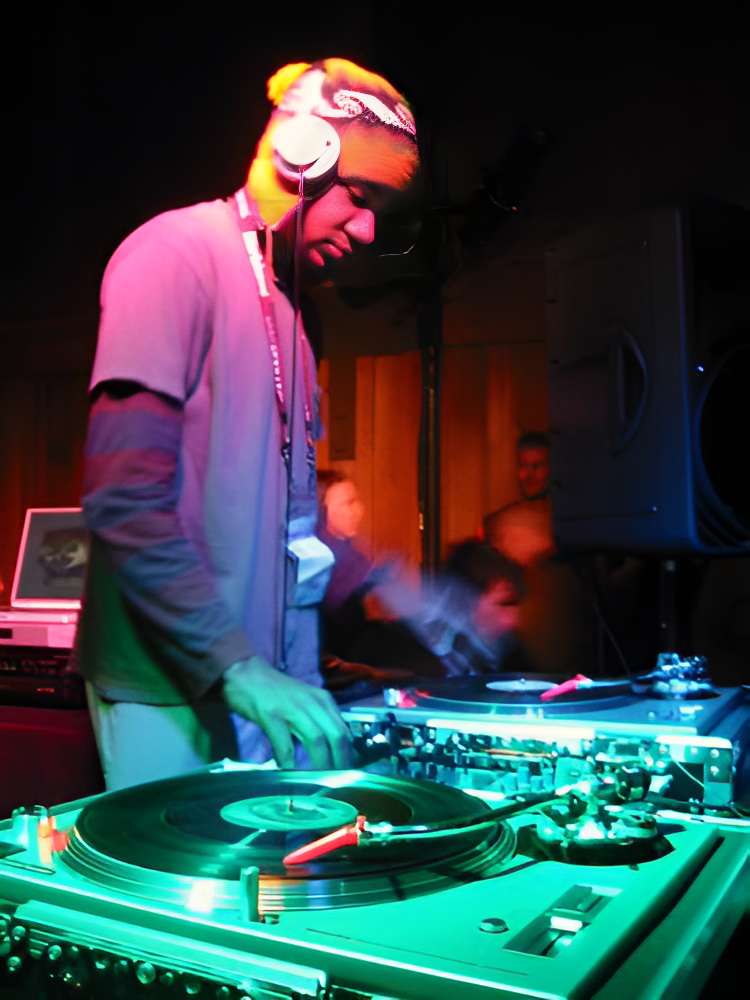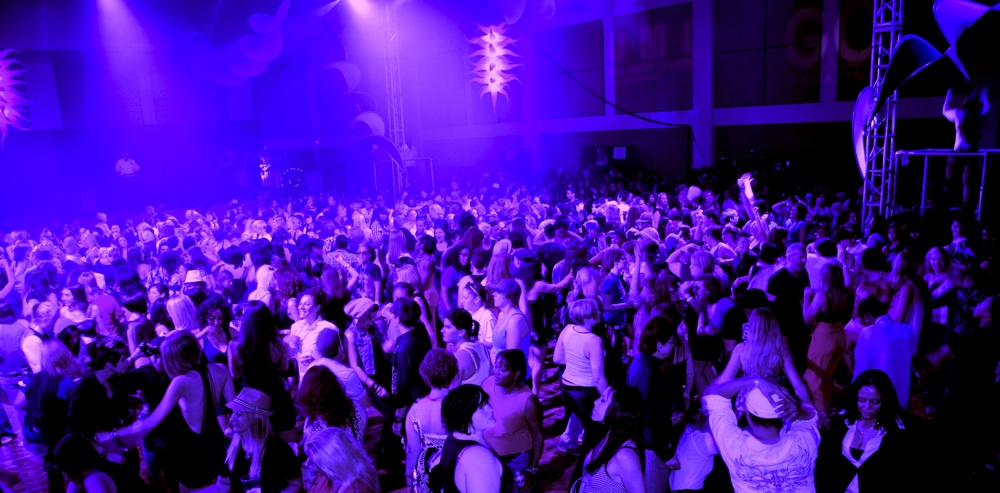|
Discothek
A nightclub or dance club is a club that is open at night, usually for drinking, dancing and other entertainment. Nightclubs often have a bar and discotheque (usually simply known as disco) with a dance floor, laser lighting displays, and a stage for live music or a disc jockey (DJ) who mixes recorded music. Nightclubs tend to be smaller than live music venues like theatres and stadiums, with few or no seats for customers. Nightclubs generally restrict access to people in terms of age, attire, personal belongings, and behaviors. Nightclubs typically have dress codes to prohibit people wearing informal, indecent, offensive, or gang-related attire from entering. Unlike other entertainment venues, nightclubs are more likely to use bouncers to screen prospective patrons for entry. The busiest nights for a nightclub are Friday and Saturday nights. Most nightclubs cater to a particular music genre or sound for branding effects. Some nightclubs may offer food and beverages (incl ... [...More Info...] [...Related Items...] OR: [Wikipedia] [Google] [Baidu] |
Discothèque (other)
A discothèque, is an entertainment venue or club with recorded music rather than a live band. It may be part of a nightclub. Discothèque or ''variants'' may also refer to: Music Albums *Discothèque (Herbie Mann album), ''Discothèque'' (Herbie Mann album), 1975 *Discotheque (Stereo Total album), ''Discotheque'' (Stereo Total album), 2005 *Discothèque (Marcia Hines album), ''Discothèque'' (Marcia Hines album), 2006 Songs *Discothèque (song), "Discothèque" (song), a 1997 song by U2 *Discotech (song), "Discotech" (song), a 2007 song by Young Love *Discoteque (song), "Discoteque" (song), a 2021 song by The Roop, representing Lithuania in the Eurovision Song Contest Other uses * Discotek Media, an entertainment company {{disambiguation ... [...More Info...] [...Related Items...] OR: [Wikipedia] [Google] [Baidu] |
Doof
A doof or bush doof is a type of outdoor dance party generally held in a remote country area, or outside a large city in surrounding bush or rainforest. Events referred to as ''doofs'' are now held worldwide and have built from a small set of social groups to a subculture with millions of active members worldwide, considered by some as a full blown culture similar to raves or teknivals. Doofs generally have healing workshops, speakers, art, live artists and DJs playing a range of electronic music, commonly Goa trance, goa, House music, house, dub techno, Techno, Psychedelic music, acid heavy sounds and psychedelic trance. "Doof doof" is a term in Australia and New Zealand for loud electronic music centred on a heavy bass drum kick. Etymology The name is onomatopoeic, and is derived from the sound of the kick drum used in the electronic music frequently lettered (as in "doof doof doof doof music"). According to Peter Strong, the original term "doof" was created in Newtown, Sy ... [...More Info...] [...Related Items...] OR: [Wikipedia] [Google] [Baidu] |
Loudspeaker
A loudspeaker (commonly referred to as a speaker or, more fully, a speaker system) is a combination of one or more speaker drivers, an enclosure, and electrical connections (possibly including a crossover network). The speaker driver is an electroacoustic transducer that converts an electrical audio signal into a corresponding sound. The driver is a linear motor connected to a diaphragm, which transmits the motor's movement to produce sound by moving air. An audio signal, typically originating from a microphone, recording, or radio broadcast, is electronically amplified to a power level sufficient to drive the motor, reproducing the sound corresponding to the original unamplified signal. This process functions as the inverse of a microphone. In fact, the ''dynamic speaker'' driver—the most common type—shares the same basic configuration as a dynamic microphone, which operates in reverse as a generator. The dynamic speaker was invented in 1925 by Edward W. Kellogg ... [...More Info...] [...Related Items...] OR: [Wikipedia] [Google] [Baidu] |
Light Beam
A light beam or beam of light is a directional projection of light energy radiating from a light source. Sunlight forms a light beam (a sunbeam) when filtered through media such as clouds, foliage, or windows. To artificially produce a light beam, a lamp and a parabolic reflector is used in many lighting devices such as spotlights, car headlights, PAR Cans, and LED housings. Light from certain types of laser has the smallest possible beam divergence. Visible light beams From the side, a beam of light is only visible if part of the light is scattered by objects: tiny particles like dust, water droplets ( mist, fog, rain), hail, snow, or smoke, or larger objects such as birds. If there are many objects in the light path, then it appears as a continuous beam, but if there are only a few objects, then the light is visible as a few individual bright points. In any case, this scattering of light from a beam, and the resultant visibility of a light beam from the side, ... [...More Info...] [...Related Items...] OR: [Wikipedia] [Google] [Baidu] |
VJing
VJing (pronounced: ''VEE-JAY-ing'') is a broad designation for realtime visual performance. Characteristics of VJing are the creation or manipulation of imagery in realtime through technological mediation and for an audience, in synchronization to music. VJing often takes place at events such as concerts, nightclubs, music festivals and sometimes in combination with other performative arts. This results in a live multimedia performance that can include music, actors and dancers. The term VJing became popular in its association with MTV's Video Jockey but its origins date back to the New York club scene of the 1970s. In both situations VJing is the manipulation or selection of visuals, the same way DJing is a selection and manipulation of audio. One of the key elements in the practice of VJing is the realtime mix of content from a "library of media", on storage media such as VHS tapes or DVDs, video and still image files on computer hard drives, live camera input, or from comp ... [...More Info...] [...Related Items...] OR: [Wikipedia] [Google] [Baidu] |
Disc Jockey
A disc jockey, more commonly abbreviated as DJ, is a person who plays recorded music for an audience. Types of DJs include Radio personality, radio DJs (who host programs on music radio stations), club DJs (who work at nightclubs or music festivals), mobile DJs (who are hired to work at public and private events such as weddings, parties, or festivals), and turntablism, turntablists (who use record players, usually turntables, to manipulate sounds on phonograph records). Originally, the "disc" in "disc jockey" referred to shellac and later vinyl records, but nowadays DJ is used as an all-encompassing term to also describe persons who DJ mix, mix music from other recording media such as compact cassette, cassettes, Compact disc, CDs or digital audio files on a CDJ, controller, or even a laptop. DJs may adopt the title "DJ" in front of their real names, adopted pseudonyms, or stage names. DJs commonly use audio equipment that can play at least two sources of recorded music simul ... [...More Info...] [...Related Items...] OR: [Wikipedia] [Google] [Baidu] |
Smiley
A smiley, sometimes called a smiley face, is a basic ideogram representing a Smile, smiling face. Since the 1950s, it has become part of popular culture worldwide, used either as a standalone ideogram or as a form of communication, such as emoticons. The smiley began as two dots and a line representing eyes and a mouth. More elaborate designs in the 1950s emerged, with noses, eyebrows, and outlines. New York radio station WMCA (AM), WMCA used a yellow and black design for its ''"WMCA (AM)#Good Guys era, Good Guys"'' campaign in the early 1960s. More yellow-and-black designs appeared in the 1960s and 1970s, including works by Harvey Ross Ball in 1963, and The Smiley Company, Franklin Loufrani in 1971.INPI Brand: FR1199660 ***RENEWAL*** OF THE DEPOSIT MADE ON OCTOBER 1, 1971 AT THE National Institute of Industrial Property (Fra ... [...More Info...] [...Related Items...] OR: [Wikipedia] [Google] [Baidu] |
Rave
A rave (from the verb: '' to rave'') is a dance party at a warehouse, club, or other public or private venue, typically featuring performances by DJs playing electronic dance music. The style is most associated with the early 1990s dance music scene when DJs played at illegal events in musical styles dominated by electronic dance music from a wide range of sub-genres, including drum and bass, dubstep, trap, break, happy hardcore, trance, techno, hardcore, house, and alternative dance. Occasionally live musicians have been known to perform at raves, in addition to other types of performance artists such as go-go dancers and fire dancers. The music is amplified with a large, powerful sound reinforcement system, typically with large subwoofers to produce a deep bass sound. The music is often accompanied by laser light shows, projected coloured images, visual effects and fog machines. Fuelled by the emerging dance scene, and spearheaded by acid house music and undergro ... [...More Info...] [...Related Items...] OR: [Wikipedia] [Google] [Baidu] |
Concert Tour
A concert tour (or simply tour) is a series of concerts by an artist or group of artists in different cities, countries or locations. Often, concert tours are named to differentiate different tours by the same artist and to associate a specific tour with a particular album or product. Especially in the popular music world, such tours can become large-scale enterprises that last for several months or even years, are seen by hundreds of thousands or millions of people, and bring in millions of dollars in ticket revenues. A performer who embarks on a concert tour is called a touring artist. Different segments of longer concert tours are known as "legs". The different legs of a tour are denoted in different ways, dependent on the artist and type of tour, but the most common means of separating legs are dates (especially if there is a long break at some point), countries and/or continents, or different opening acts. In the largest concert tours, it has become more common for differen ... [...More Info...] [...Related Items...] OR: [Wikipedia] [Google] [Baidu] |
Circuit Party
A circuit party is a large dance event. It extends through the night and into the following day, almost always with a number of affiliated events in the days leading up to and following the main event. Proto-circuit parties in the late 1970s, the precursors of what later became circuit parties, were called disco parties. They lasted only one evening and were held in various large venues in metropolitan areas with large gay populations. Circuit parties were first developed in connection with the early tea dance (gay event), tea dances, attended by a subset of gay men, as well as theme parties held on Fire Island and The Hamptons on Long Island. They came to resemble underground rave party, rave parties in some respects, but differ in that circuit parties are highly publicized and professionally produced, and tend to attract people from a wider age range and a broader geographic area. Background Founding as disco parties (1970s) The start of the circuit has been attributed to m ... [...More Info...] [...Related Items...] OR: [Wikipedia] [Google] [Baidu] |
Free Party
A free party is a party "free" from the restrictions of the legal club scene, similar to the Free festival, free festival movement. It typically involves a Sound system (DJ)#Free party, sound system playing electronic dance music from late at night until the time when the organisers decide to go home. A free party may be multiple sound systems. If the party becomes a festival, it becomes a teknival. ''Free'' in this context describes the entry fee and the lack of restrictions and law enforcement. Organiser motivations range from political protest to simply wanting to have fun. An example of free parties as political protest was their prominence during the M11 link road protest. At most parties no money is asked for entrance since profit is not the aim. Some (often indoor) events request Donation, donations at the door to cover costs. Typically organisers make little profit or a loss setting them up. The term free party is used more widely in Europe than in the US. In Canada an ... [...More Info...] [...Related Items...] OR: [Wikipedia] [Google] [Baidu] |
Free Festival
Free festivals are a combination of music, arts and cultural activities, for which often no admission is charged, but involvement is preferred. They are identifiable by being multi-day events connected by a camping community without centralised control. The pioneering free festival movement started in the UK in the 1970s. History David Bowie's song Memory of a Free Festival, recorded in September 1969 and included on the 1969 album David Bowie, mentions the free festival organised by the Beckenham Arts Lab and held on the Croydon Road Recreation Ground on 16 August 1969. The 1972 to 1974 Windsor Free Festival, held in Windsor Great Park, England, was a free festival. The 'organisation' was mostly Ubi Dwyer distributing thousands of leaflets and asking people and bands to bring their own equipment and create their own environment – "bring what you expect to find." "Free festivals are practical demonstrations of what society could be like all the time: miniature utopias ... [...More Info...] [...Related Items...] OR: [Wikipedia] [Google] [Baidu] |









